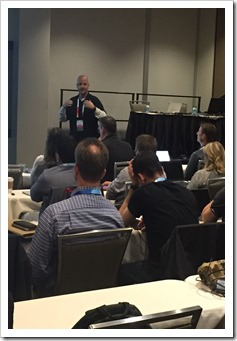 Over the course of several years, I have given many technical and non-technical presentations. It is fun for me to put a new slide deck together, but it also requires a lot of hard work and can be time-consuming. I’ve had a few mistakes, to say the least, over the years where that one typo slips through or something doesn’t go according to plan ~ guess what? It happens.
Over the course of several years, I have given many technical and non-technical presentations. It is fun for me to put a new slide deck together, but it also requires a lot of hard work and can be time-consuming. I’ve had a few mistakes, to say the least, over the years where that one typo slips through or something doesn’t go according to plan ~ guess what? It happens.
I compare articulating a presentation to similar fashion in testing something. Yeah, you go over it again and again just like you would test a backup process or verify indexes are actually working. For me the same concept applies; I can’t remember who in the SQL Community always mentions having a checklist handy. I know I’ve read that somewhere before but cobwebs are thick right now so, please, forgive me if I don’t remember. Through the years, I’ve managed to build my own checklist regarding presentations. It is the nuts and bolts of what works for me; it doesn’t necessarily mean it, in turn, will work for you.
Given light of some past conversations I’ve had, I figured I’d share it with you all and maybe someone out there will benefit from it.
Presentation Checklist (a.k.a. Project Double Check Yourself)
What is the purpose – fully understand the purpose of the presentation. By that I mean, what outcome are you seeking?
- To inform
- To convince
- To generate insight and discussion
- To drive action
Know your audience
- Do you know who my audience is? Have I provided adequate context to make it easier for them to understand?
- Are there any personal motivations that you need be aware of?
- Is the audience familiar with the topic? Have you included adequate detail and background information?
- Is the presentation tailored to fit the audiences communication style?
Know the message
- If applicable, do you know the problem or issue you are trying to address?
- Do you have three to five key teaching points you want to deliver? If so, have you tied those teaching points logically and clearly to the original problem?
- Have you clearly linked your teaching points to key data or trends along with explaining how the analysis supports, confirms, or denies beliefs about the problem and/or possible solutions?
- Have you limited the data to what matters most?
- Have you clearly established relevance? (why would your audience care? Have you clearly highlighted how this aligns with the target audience?)
- Have you clearly established urgency (why would the audience act now; why is it critical?)
Structure
- Is the presentation clearly marked with markers and sign posts? Is it easy to follow?
- Is there an agenda that clearly identifies the different elements and how it fits together? Key point up front?
- Are there additional details about internal or external sources that were consulted for the included information? Give credit where credit is due
Narrative
- Does the presentation include insights that will be most influential to the audience? Is the scripting memorable and powerful?
- Does the presentation identify key assumptions?
- Does the presentation articulate immediate actions that you believe the audience should take?
Graphics
- Do you know the purpose of each graphic? Is it tied to a teaching point in the message?
- Do the graphics present information in a logical, visually appealing manner? Are there other ways of interpreting the graphic other than your intention?
- Is the page balanced?
Formatting
- Does the presentation have a standardized look and feel (same headings, colors, fonts)?
- Are page elements consistent (background, title, body text)?
- Are colors used judiciously (to emphasize, highlight, and organize)
Conclusion
Checklists; they are everywhere. They don’t necessarily have to be for technical related activities; heck we use checklists for grocery items. They are a part of our daily lives; so when you get that presentation built and you are ready to give it at your shop, on the job, a conference or a client take a few minutes and review a checklist. Make sure you have your house in order and that everything makes sense.
Remember, you get out what you put into something. Continue to work hard and hone in on your speaking and presentation talents that lie within. Like I said, these are some of the things that have helped me over the years; doesn’t mean they are for everyone. The flip side to that, you may have some of your own to share. I encourage you to do so.


